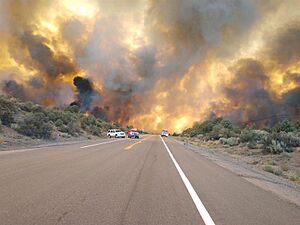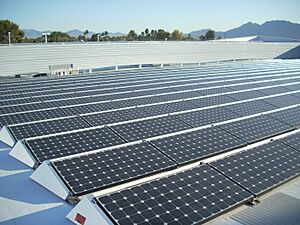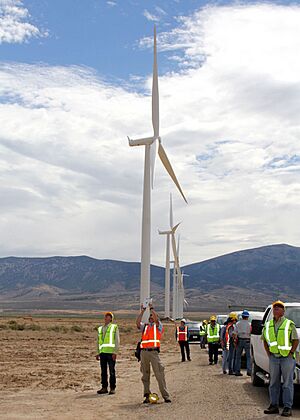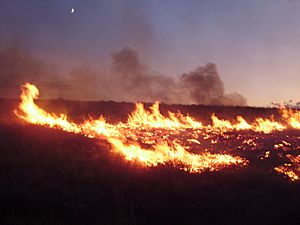Climate change in Nevada facts for kids

Climate change in Nevada means changes in the state's weather patterns over a long time. Over the last 100 years, the average temperature in Elko, Nevada has gone up a little. Rain and snow have also increased by about 20% in many areas. Scientists are studying if these changes will keep happening in the future.
Contents
What Might Change in Nevada's Climate?
Experts believe that Nevada's climate could change even more during the 21st century. Based on scientific models, temperatures might increase by 3-4 °F (1.7-2.2 °C) in spring and fall by the year 2100. In winter and summer, temperatures could rise even more, by 5-6 °F (2.8-3.3 °C).
Rain and snow patterns are also expected to shift.
- Summer precipitation might decrease by 10%.
- Spring precipitation could increase by 15%.
- Fall precipitation might increase by about 30%.
- Winter precipitation could increase by about 40%.
It's important to remember that different climate models can show slightly different results. However, most models agree on some key points. For example, extremely wet or snowy days in winter are likely to become more common. Also, the number of very hot days in summer would probably increase. It's not clear how severe storms might change, but stronger winter storms are possible.
How Will Water Resources Be Affected?
Nevada's rivers and streams get most of their water from snow melting in the mountains during spring and summer. If snow melts earlier and faster, it could lead to more floods in winter and spring. More intense summer storms could also cause flash floods. Even though Nevada is very dry, heavy rains can quickly create powerful flows of water and mud. Homes and businesses built in valleys or near hills are especially at risk during flash floods.
Las Vegas Water Supply
After a big drought in 2002, people in Las Vegas became worried about their water supply. They have worked hard to use less water. Daily water use per person dropped from 314 gallons in 2003 to about 205 gallons today. Even with these efforts, people in Las Vegas still use more water than those in Los Angeles or San Francisco.
The Southern Nevada Water Authority is building a large tunnel and pumping station. This project will help Las Vegas keep getting water from Lake Mead. It's designed to work even if the water level drops so low that the Hoover Dam's generators and pumps stop working. This is a big step to make sure the city has enough water in the future.
What About Farming?
Farming in Nevada is a big business, bringing in about $300 million each year. Most of this money comes from raising livestock, mainly cattle. Almost all farms in Nevada use irrigation to water their crops. The main crops grown are hay and potatoes.
Climate change could affect how much food farmers can grow. Potato harvests might drop by about 12%. However, hay and pasture yields could increase by about 7%. The total amount of land used for farming might go up or down by 9%, depending on how the climate changes. Raising livestock might not be affected much, unless summers become much hotter and drier. If that happens, animals might gain less weight, and there would be less grass for them to eat.
How Will Forests Change?
Climate change could cause Nevada's forests to shrink by 15-30%. This depends on whether the soil becomes drier, and how much drier it gets. Hotter and drier weather could also lead to more frequent and intense wildfires. These fires threaten both homes and the forests themselves.
Drier conditions would harm ponderosa pine and lodgepole pine forests in northern and western Nevada. These trees would become more likely to catch fire. Grasslands and deserts might expand into areas that used to be forests. Milder winters could also lead to more insect outbreaks, which then leave dead trees that can easily burn. These changes would greatly affect Nevada's forests and the activities that rely on them. More rainfall could help reduce some of these problems.
What About Ecosystems?
Nevada's water and climate systems naturally change a lot. Climate change could make them even more unpredictable. This would put stress on wetland ecosystems, which are areas of land covered by water.
Nevada's streams and rivers get all their water from springs or from mountain snowmelt. A warmer climate would cause more water to evaporate. It would also shorten the snow season in the mountains. This means snow would melt earlier in spring, and there would be less water in streams during summer. This would also increase the risk of fires in late summer.
These threats, combined with people needing more water, could severely reduce the number and quality of wetland habitats. These habitats are already struggling and often dry up. This would harm places where birds migrate and breed. It could also put more stress on rare and endangered fish species. Many desert plants and animals already live in very tough conditions. They might disappear if temperatures get even hotter, as predicted with global warming.









